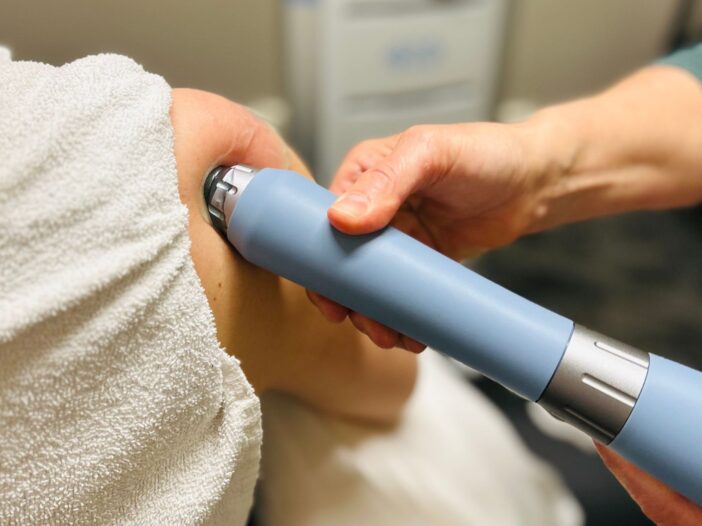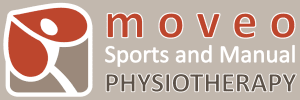
Shockwave therapy (in Orléans, Ottawa) is a highly effective treatment for chronic pain relief of tendons, bursitis, myofacial pain. Effects are often felt with the first treatment.
What is Shockwave Therapy?
Shockwave or Extracorporeal shockwave therapy (ESWT) was first introduced in the 1980’s for the treatment of kidney stones. Since then, it has evolved and been adapted to treat musculoskeletal conditions. This modality is being used more in a clinical setting and is a great way to address a chronic condition that has failed to previous conventional treatment.
Shockwave emits low energy acoustic waves directly onto the skin of the patient along the painful site. This is coupled with ultrasound gel to improve the contact on the surface area. Shockwave therapy accelerates the healing process in the body by stimulating the metabolism and enhancing blood circulation to regenerate damaged tissue. Strong energy pulses are applied to the affected area for short periods of time, creating micro-cavitation bubbles that expand and burst. The force created by these bubbles stimulates cells in the body that are responsible for bone and connective tissue healing.

How Does it Work?
Shockwave creates a stimulation on a cellular level and therefore stimulates growth factor. This results in regeneration of the tissue secondary to the growth of new vessels which improves blood supply to the problematic area.
Essentially, shockwave creates an inflammatory response, in an area that halted the healing process secondary to its chronicity. An inflammation response is necessary for the healing process to occur.
What are the Beneficial Effects of Shockwave Therapy?
- Tissue regeneration
- Elimination of calcification
- Pain relief
- Muscle relaxation
- Reversal of chronic inflammation
This treatment works without the use of drugs or x-rays. It stimulates the body’s natural self-healing process. There is often an immediate reduction of pain and improved range of motion.
What Conditions Can be Treated With Shockwave Therapy?
Shockwave therapy is indicated for many musculoskeletal conditions, such as:
- Array of tendinopathies to both upper and lower extremities, to name a few:
- Achilles
- Patellar
- Tennis and golfers elbow
- Calcific tendinopathy (rotator cuff)
- Plantar fasciitis
- Heel spurs
- Frozen Shoulder
- Greater trochanter dysfunction (chronic bursitis, myofascial pain)
- Myofascial dysfunction, such as trigger points in an array of anatomical areas.
- Piriformis Syndrome, Iliotibial Band (ITB) Syndrome
- Morton’s neuroma
- Shin splints
- Impingement syndromes
- Stress fractures
- Broken bones that have failed to heal (non-union)
Are You a Good Candidate for Shockwave Therapy?
Rule of thumb, your pain must be of chronic nature, meaning, present for more than 3 months. Shockwave is not indicated for acute conditions. In fact, shockwave is a good modality to consider if other conventional approaches have failed.
There are counter indications to treatment. These are some examples but are not exhaustive. Your therapist will go through a detailed medical history to determine if you are a good candidate for shockwave while taking in consideration your desired treatment area.
- Pregnancy
- Blood thinner medication
- Coagulation and blood disorders
- Certain areas of the body, such as the skull, eyes, facial bones, gonads, liver and kidneys
- On active cancer sites / tumor diseases
- If you are diagnosed with polyneuropathy
- Areas of growth plates in children
- Thrombosis / history of blood cloth
- Areas near large blood vessels, nerve bundles
- Recent cortisone injection in the treatment area (6 weeks)
- If you have a pacemaker or defibrillator
Is the Treatment Painful?
Pain is a subjective measure, meaning pain is experienced and perceived differently between each individual. This type of treatment can be uncomfortable, but not necessarily painful. Your therapist will introduce you to the treatment and if well tolerated, will continue. The intensity can be adjusted depending on your response.
How Long Will a Treatment Last?
The day of treatment, you can except the actual shockwave treatment to last approximately 5-10 minutes depending on the area being treated. We aim for 2000-6000 shocks, depending on the area. The therapist will adjust the dosage depending on your tolerance and reaction. The recommendation total dosage of treatment varies between 3-8 treatments, at once a week interval. The area being treated and the evolution of the patient’s condition will determine the series of treatment needed.
What to Expect on Your First Appointment
On your first appointment, you will go through a regular physiotherapy assessment, which lasts typically 30-45 minutes. During this time, you will be thoroughly assessed to determine the right treatment plan. Your therapist will then go through the findings of the assessment. Education is key for you to understand your condition and understand the treatment plan. We spend time discussing anatomy findings and where the problem may be coming from. If shockwave is the right plan, we will proceed with the first treatment the same day!
We always go through the risks and benefits of a treatment. Therefore, you will be able to give your full consent prior to starting the treatment plan. We will answer all questions related to shockwave therapy. There is also a detailed consent which must be signed on your initial treatment. Your therapist will review the consent with you.
Your therapist may express further plans after shockwave, or subsequently, which could include a home exercise program, manual therapy, other treatments which could address the anatomical area which caused the problem in the first place.
What Should You Expect After Treatment
The shockwave will trigger and inflammatory response, which is the body’s natural response of healing. This may cause certain adverse events including but not limited to: swelling, bruising, reddening, hematomas, increase or new onset of temporary pain. Side effects usually dissipate after a few days.
However, in most cases, patients find relief in pain and may even gain range of motion if it was limited prior to treatment.
What is the Cost of Treatment?
Cost will vary depending on the clinic. Please call us to learn more in detail regarding our pricing for shockwave therapy.
Our professional services are not covered by O.H.I.P., but may be covered through your extended health care plan. Receipts are provided for you to submit to your insurance company if coverage is applicable to your plan. Invoices are to be paid after each treatment. The invoice will mention Shockwave Therapy. It is your responsibility to verify if you are covered and if there is a limit amount per treatment to your coverage. Our fees reflect the quality of the service we are providing.
What is the Success Rate for This Type of Treatment?
An array of scientific studies has been conducted to assess the outcome of shockwave therapy on many musculoskeletal conditions.
Some research has shown long term relief after treatment, high rate of return to sports faster, significant decrease in pain, effective non-operative treatment, helpful when conventional therapy has failed.
More details can be retrieved from: https://www.orthocanada.com/en/radial-shockwave-therapy#results
What if Shockwave Therapy Does Not Work for Me?
Changes will likely be progressive throughout the next few weeks and after each treatment.
The long-term benefits of this treatment may take up to 3-4 months to notice after the last treatment. If after this time there has not been any marked improvement, additional imaging or exploring other treatment plan and other professional services may be indicated. Your physiotherapist will collaborate with your physician or other health care professionals to ensure proper continuity of care.
Our team is also dedicated to treat the cause of your complaint. This means that your physiotherapist may discuss continuity of care to address the cause of your complaint if it applies to you
Contact us about Manual Therapy in Orléans, Ottawa


